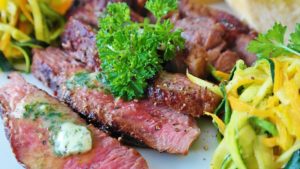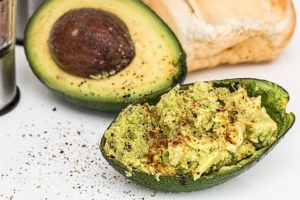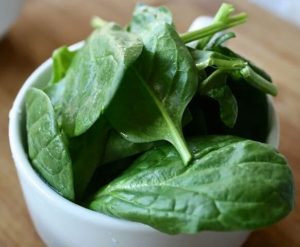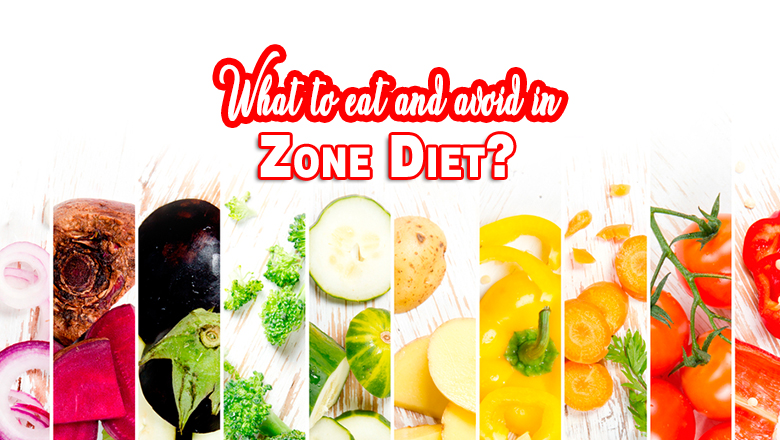A lot of the favorable Zone Diet food choices are similar to those of the Mediterranean Diet, which is one of the healthiest diets.
In fact, the creator of the Zone Diet has recently released a new book called The Mediterranean Zone, in which he covers the similarities and benefits of the two diets.
Protein
The Zone diet treats protein as a prescription drug. Once you’ve determined how much protein you need to eat (based on your fat stores and your activity level), you need to spread your intake of protein throughout the day to keep your levels as even as possible, just as you’d spread a prescribed medication throughout the day.
Since different types of protein affect your body in different ways (protein high in saturated fat, such as fatty red meat, organ meat, and egg yolks, stimulates inflammation and insulin resistance),
Protein options in the Zone Diet should be lean. Good options include:

Protein
Lean beef, pork, lamb, veal and game
Skinless chicken and turkey breast
Fish and shellfish
Vegetarian protein, tofu, other soy products
Egg whites
Low-fat cheeses
Low-fat milk and yogurt
Fat

Fat
Every Zone diet-complaint meal should include fat, since fat helps your body absorb some of the nutrients in your food and also assists your body in creating eicosanoids, the helpful hormones Dr. Sears wants to promote. Although it’s possible to get fat from fattier cuts of meat, the Zone diet recommends against this approach, since the fat contained in meat isn’t the correct type of fat.
The Zone Diet encourages choosing a type of monounsaturated fat. Good options include:
Avocados
Nuts, such as macadamia, peanuts, cashews, almonds or pistachios
Peanut butter
Tahini
Oils such as canola oil, sesame oil, peanut oil and olive oil
Carbs
The Zone Diet encourages its followers to choose vegetables with a low glycemic index and a little fruit.
Carbohydrates

Carbohydrates
Once you know how much protein you should be eating on a daily basis, it’s easy to match that to carbohydrates. The Zone diet calls for you to eat 9 grams of carbohydrate for every 7 grams of protein. Recommended carbohydrate-based foods are those with a low glycemic index—that means they raise your blood sugar slowly, rather than quickly.
Most fruits and vegetables as carbohydrate sources, including green leafy vegetables. Good options include:
green leafy vegetables such as spinach,
kale, and collard greens,
raw vegetables such as peppers, lettuce, and broccoli,
cooked vegetables such as eggplant, cabbage, and onions,
fruit such as apples, berries, melon, citrus such as oranges and grapefruit, and peaches.
The Zone diet doesn’t require animal-based foods, so if you’re a vegetarian or vegan, it’s not problematic to try the Zone diet. However, you should be aware that multiple vegetarian and vegan staple foods, including grains and beans, are off-limits on the Zone diet due to their high starch content.
What Can’t You Eat on the Zone Diet?
Nothing is strictly banned on the Zone Diet. However, certain food choices are considered unfavorable because they promote inflammation.
High-sugar fruits: Such as bananas, grapes, raisins, dried fruits and mangoes.
High-sugar or starchy vegetables: Like peas, corn, carrots and potatoes.
Refined and processed carbs: Bread, bagels, pasta, noodles and other white-flour products.
Other processed foods: Including breakfast cereals and muffins.
Foods with added sugar: Such as candy, cakes and cookies.
Soft drinks: Neither sugar-sweetened nor sugar-free drinks are recommended.
Coffee and tea: Keep these to a minimum, since water is the beverage of choice.
Staying in the Zone requires sticking to the rules. You’re supposed to eat a meal within an hour of waking, never let more than five hours go by without eating, and have a snack before bedtime.
Limitations: The Zone diet breaks down protein, carbs, and fat into “blocks” that correspond to the amount of each you can have at each meal and snack. You can’t pile on the protein at lunch and then have all carbs for dinner. Women should have 11 blocks per day; men should have 14 blocks per day.
Restrictions in the diet
Vegetarians and vegans: With two-thirds of your plate filled with fruits and veggies, the Zone Diet is an easy fit for vegetarians or vegans.
It’s also easy to be gluten-free on The Zone, since the diet strongly discourages eating wheat, barley, and rye products. However, you’ll still need to check food labels carefully to completely avoid gluten.
Low-salt diet: With an emphasis on fresh ingredients rather than high-sodium processed foods, maintaining a low-salt diet while on the Zone shouldn’t be a challenge.
Although the Zone diet is touted as one that can help you ward off serious chronic health conditions such as heart disease, diabetes, and cancer, people who already have been diagnosed with those conditions should talk to their doctors about whether the food restrictions in the diet are best for them.
